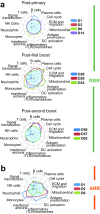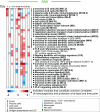Systems analysis of protective immune responses to RTS,S malaria vaccination in humans
- PMID: 28193898
- PMCID: PMC5338562
- DOI: 10.1073/pnas.1621489114
Systems analysis of protective immune responses to RTS,S malaria vaccination in humans
Abstract
RTS,S is an advanced malaria vaccine candidate and confers significant protection against Plasmodium falciparum infection in humans. Little is known about the molecular mechanisms driving vaccine immunity. Here, we applied a systems biology approach to study immune responses in subjects receiving three consecutive immunizations with RTS,S (RRR), or in those receiving two immunizations of RTS,S/AS01 following a primary immunization with adenovirus 35 (Ad35) (ARR) vector expressing circumsporozoite protein. Subsequent controlled human malaria challenge (CHMI) of the vaccinees with Plasmodium-infected mosquitoes, 3 wk after the final immunization, resulted in ∼50% protection in both groups of vaccinees. Circumsporozoite protein (CSP)-specific antibody titers, prechallenge, were associated with protection in the RRR group. In contrast, ARR-induced lower antibody responses, and protection was associated with polyfunctional CD4+ T-cell responses 2 wk after priming with Ad35. Molecular signatures of B and plasma cells detected in PBMCs were highly correlated with antibody titers prechallenge and protection in the RRR cohort. In contrast, early signatures of innate immunity and dendritic cell activation were highly associated with protection in the ARR cohort. For both vaccine regimens, natural killer (NK) cell signatures negatively correlated with and predicted protection. These results suggest that protective immunity against P. falciparum can be achieved via multiple mechanisms and highlight the utility of systems approaches in defining molecular correlates of protection to vaccination.
Keywords: immune; malaria; systems biology; systems vaccinology; vaccine.
Conflict of interest statement
Conflict of interest statement: R.v.d.M., R.A.v.d.B., W.R.B., and E.J. are employees of the GSK group of companies. They report ownership of GSK shares and/or restricted GSK shares.
Figures















References
-
- World Health Organization 2015. World Malaria Report (World Health Organization, Geneva)
-
- Strategic Advisory Group of Experts Meeting of the Strategic Advisory Group of Experts on immunization, October 2015 - conclusions and recommendations. Wkly Epidemiol Rec. 2011;90(50):681–699. - PubMed
-
- Cohen J, Nussenzweig V, Nussenzweig R, Vekemans J, Leach A. From the circumsporozoite protein to the RTS, S/AS candidate vaccine. Hum Vaccin. 2010;6(1):90–96. - PubMed
-
- Casares S, Brumeanu TD, Richie TL. The RTS,S malaria vaccine. Vaccine. 2010;28(31):4880–4894. - PubMed
-
- Didierlaurent AM, et al. Enhancement of adaptive immunity by the human vaccine adjuvant AS01 depends on activated dendritic cells. J Immunol. 2014;193(4):1920–1930. - PubMed
Publication types
MeSH terms
Substances
Grants and funding
LinkOut - more resources
Full Text Sources
Other Literature Sources
Molecular Biology Databases
Research Materials
Miscellaneous

